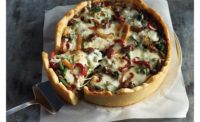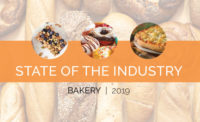At first glance, it might not seem that the bread aisle has changed all that much of late. Many of the same traditional products are performing as expected.
But look closer, and you’ll see sliced bread products that look remarkably like their artisan cousins. Dig deeper, and clearly organic is starting to surface with more regularity. And it’s now obvious that seeds are sprouting up all over.
Overview | Bread | Tortillas | Sweet Goods | Snack Cakes | Pizza | Desserts | Cookies | Buns & Rolls | Bars | Breakfast Products
While fresh bread remains flat, bakers are innovating to drive incremental growth. And it’s starting to work.
Market data
According to data from IRI, Chicago, fresh bread remained flat for yet another year, up only 0.09 percent to $9.1 billion for the 52 weeks ending March 25, 2018. Only two companies showed any notable level of growth, with Flowers Foods growing 4.41 percent in dollar sales to $2.0 billion and H&S Bakery up 4.9 percent to $90.6 million.
The bagels/bialys category saw a nice turnaround for the year, up 4.81 percent to $884.4 million. Bimbo Bakeries USA and its Thomas’ brand lead the category, with a 2.14 percent increase to $576.6 million for the year. Flowers Foods, which extended its Dave’s Killer Bread brand into the bagel market in early 2017, saw notable growth of 136.4 percent to $39.3 million. SJB Bagel Makers of Boston—commonly known as Finagle a Bagel—broke into the top 10 companies in the category with 81.09 percent growth to $4.8 million.
English muffins dropped slightly for the year, down 1.34 percent to $726.5 million. Bimbo and Thomas’ also rule here, taking in $596.4 million but down slightly by 1.63 percent. Vermont Bread Co. continued strong growth again this year, up 18.57 percent to $8.3 million. Pinnacle Goods gluten-free brand Udi’s brought English muffins to market over the past year and saw sales of $2.1 million.
Looking back
Jonathan Davis, senior vice president of R&D, La Brea Bakery, Los Angeles, notes that one big trend he is seeing is smaller product sizes. “La Brea Bakery recently started offering a demi-baguette size in our Reserve portfolio.” This brings a good option to consumers looking for a smaller loaf—and can help eliminate food waste.
“A greater choice of ingredients is the hottest current trend, particularly whole-grain, seeded, high-fiber, artisan and sourdough-type breads,” says Keith Graham, marketing manager, Baker Perkins, Peterborough, England.
“Consumers are looking for simple twists on perennial favorites, either with added nutrition or less sugar,” says Nicole Rees, product director, AB Mauri North America, St. Louis. She notes AB Mauri has an enzyme-based solution that brings natural sweetness to bread formulas, eliminating the need for added sugar.
“In the last 10 years, we’ve seen dominant shelf space positions transform from white bread to wheat bread to functional breads to whole-grain breads to, now, clean-label breads,” says Catherine Barry, director of marketing, National Honey Board, Firestone, CO. She notes that this evolution has helped increase the demand for honey, as whole-grain and clean-label breads benefit from the flavor, functionality and marketing benefits of the sweetener.
“Clean label is more than a trend—it’s a paradigm shift,” says Cam Suárez-Bitár, marketing and public relations manager, Bellarise, Pasadena, CA. “Essentially, it has changed how bread is made. It is a goal our industry must reach in order to sustain long-term growth. But it should be noted that a clean-label bread must be equally defined by its overall quality and its ability to add value for the consumer in order to consistently drive sales and customer satisfaction.”
The biggest trend in bread is still clean label, says David Guilfoyle, group application manager, bakery, fats and oils, DuPont Nutrition & Health, New Century, KS. “More ‘artisan morphed’ options are beginning to show up on the grocery shelves, especially with the success of Bimbo’s Artesano brand.”
Bimbo Bakeries USA expanded its popular Sara Lee Artesano line in October 2017 with Golden Wheat, made with honey, olive oil and sea salt, and no high-fructose corn syrup or artificial colors or flavors.
Consumers still want organic products with a homemade feel, notes says David DelGhingaro, president, Brolite Products, Streamwood, IL. “But they’re also willing to introduce new flavors and ingredients into their diets. Strong-flavored sourdoughs and artisan breads have increased in popularity, and alternative flours, such as nut flours and vegetable flours, are being used more than we’ve ever seen.” He notes Brolite has developed formulas to replace ingredients like SSL, ADA and DATEM.
Organic can be considered the original clean label, and the Flowers Foods brand Dave’s Killer Bread recently extended its line of organic bagels with a Boomin’ Berry variety made with cranberries, blueberries, blackberries and açaí berries, all clearly noted on the label. Each bagel has 11 grams of protein and 13 grams of whole grains—and no high-fructose corn syrup.
Davis points to the need for transparency in the clean-label discussion. “It’s something that we’ve brought to the forefront through projects like our partnership with Wheat Montana, which provides our customers with complete transparency around where and how the grains in our Reserve breads are grown.” This has allowed La Brea Bakery to bring single-origin wheat artisan breads to market.
Rudi’s Organic Bakery has also employed this business strategy and recently launched two Community Grains “seed to table” breads—Hungry Hollow and Sacramento Valley—that trace the grain back to the farm.
“Consumers are on the lookout for bakers who are transparent about the baking process and describe the purpose of their ingredients,” says Suárez-Bitár. “The U.S. market wants to know where its food comes from, and how it was made. Organic and Non-GMO will also continue to drive growth across the category for the foreseeable future.”
Looking forward
New product R&D needs to consider millennial preferences. “It’s no secret that U.S. millennials’ buying power exceeds that of any other generation, and that they prefer convenient and authentic foods,” says Suárez-Bitár. “Millennials simply want the truth from bakeries: clear and transparent labeling will be the way forward, along with clean label, because they want the full story.”
New flavor mash-ups are emerging, notes Guilfoyle. “Several ethnic flavor profiles to watch for are more turmeric, Spanish flavors, use of walnuts and higher protein contents in breads.”
Much of this ties back to health and wellness. Rees suggests breads that offer gut-friendly fiber sources and proteins from plant sources, such as pulses. She notes AB Mauri’s Burgen line of grain blends and bread concentrates help bakers add nutrition, premium flavor and texture.
Graham notes that clean label is particularly important at the premium end of the market. “Clean label and free-from are likely to increase at a greater rate than current trends, largely because there is more headroom in the market.”
Bakers, however, have to balance clean label with shelf life needs and product quality, says Graham. He recommends the Baker Perkins Multitex4 moulder to improve softness in breads, helping extend shelf life. “Sticky doughs can be readily handled—without the need for flour dusting—because of the close-coupled rolls in the sheeting head.”
Products like Brolite’s BNB Extender provide softness and tenderness in breads, says DelGhingaro. He also notes that Brolite’s NI Natural Mold Inhibitor prevents mold without using calcium propionate.
Graham notes that the latest update to the Multitex4 enables creation of a fully enrobed seeded loaf by rolling the coiled dough piece in the seeds or grains before panning. “This results in seeding the top, bottom, sides and ends of the loaf, achieving overall coverage and pressing the seeds fully into the dough.” He says this significantly reduces the problem of waste caused by seeds falling off in the bag.
Bakers can improve the shelf life and quality of breads with enzyme-based crumb softening solutions, notes Marie Thomas, vice president of innovation, AB Mauri North America. “These ingredient options are clean label and can significantly reduce the rate at which bread stales, ensuring softness throughout shelf life. Flavor changes also occur over bread’s lifespan, and these can be addressed by adding cereal ferments such as Aromaferm, which enhance the overall taste and shelf life of bread.”
Honey can also help extend shelf life, notes Barry. “The ingredient’s fructose content helps clean-label breads hold in moisture.” This reduces dryness and crumbliness. She notes that honey’s acidity—average pH 3.91—also helps inhibit mold growth.
Bakeries need to consider a three-pronged approach to hyper-extended shelf life, notes Guilfoyle: softening technology, antimicrobials and antioxidants. “Many bakeries always search out for the first two in the approach, but forget antioxidation is also key to hyper-extended shelf life.”
This ever-longer shelf life is necessary because bakery manufacturers are looking at the great success Hostess created with its warehouse distribution model and are trying to figure out how to do it in their own distribution, says Guilfoyle. “Warehouse distribution opens many doors, not only to Amazon, but also to Walmart and super drugstores like Walgreens.”
Bakers are also choosing more application-specific clean-label enzyme systems that consistently improve the shelf life, volume, texture, crumb structure, bite and crust color of breads, notes Suárez-Bitár. For instance, Bellarise BellaSPONGE Organic is specifically crafted for use in organic breads that feature dairy ingredients.
The clean and organic label, and a demand for healthy, sustainable ingredients in artisan breads, will only continue to flourish, notes DelGhingaro. “Within this trend, unique flavors and more interesting varieties will be seen in the American market.”
Adding new product innovation—while also improving traditional offerings in the bread aisle—is crucial, notes Suárez-Bitár. “With regard to traditional sliced bread, a 2018 IRI study indicated that whole wheat, multigrain and honey wheat are the preferred flavor profiles for sliced breads among U.S. consumers. Whether we’re looking at breads sold at retail or foodservice, we will see cleaner labels, proven value, extended shelf life, and authentic flavors continue to drive sales, with organic and non-GMO creating a strong, dynamic pull for the consumer.”
Overview | Bread | Tortillas | Sweet Goods | Snack Cakes | Pizza | Desserts | Cookies | Buns & Rolls | Bars | Breakfast Products












